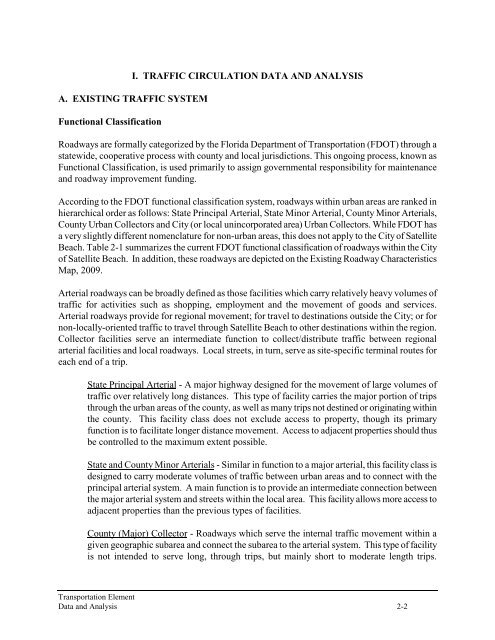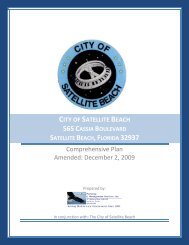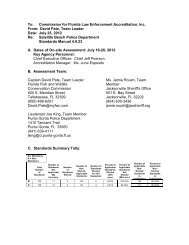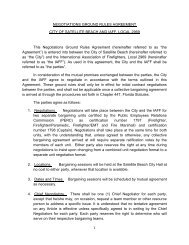Supporting Documents (Data and Analysis) - Satellite Beach
Supporting Documents (Data and Analysis) - Satellite Beach
Supporting Documents (Data and Analysis) - Satellite Beach
You also want an ePaper? Increase the reach of your titles
YUMPU automatically turns print PDFs into web optimized ePapers that Google loves.
I. TRAFFIC CIRCULATION DATA AND ANALYSIS<br />
A. EXISTING TRAFFIC SYSTEM<br />
Functional Classification<br />
Roadways are formally categorized by the Florida Department of Transportation (FDOT) through a<br />
statewide, cooperative process with county <strong>and</strong> local jurisdictions. This ongoing process, known as<br />
Functional Classification, is used primarily to assign governmental responsibility for maintenance<br />
<strong>and</strong> roadway improvement funding.<br />
According to the FDOT functional classification system, roadways within urban areas are ranked in<br />
hierarchical order as follows: State Principal Arterial, State Minor Arterial, County Minor Arterials,<br />
County Urban Collectors <strong>and</strong> City (or local unincorporated area) Urban Collectors. While FDOT has<br />
a very slightly different nomenclature for non-urban areas, this does not apply to the City of <strong>Satellite</strong><br />
<strong>Beach</strong>. Table 2-1 summarizes the current FDOT functional classification of roadways within the City<br />
of <strong>Satellite</strong> <strong>Beach</strong>. In addition, these roadways are depicted on the Existing Roadway Characteristics<br />
Map, 2009.<br />
Arterial roadways can be broadly defined as those facilities which carry relatively heavy volumes of<br />
traffic for activities such as shopping, employment <strong>and</strong> the movement of goods <strong>and</strong> services.<br />
Arterial roadways provide for regional movement; for travel to destinations outside the City; or for<br />
non-locally-oriented traffic to travel through <strong>Satellite</strong> <strong>Beach</strong> to other destinations within the region.<br />
Collector facilities serve an intermediate function to collect/distribute traffic between regional<br />
arterial facilities <strong>and</strong> local roadways. Local streets, in turn, serve as site-specific terminal routes for<br />
each end of a trip.<br />
State Principal Arterial - A major highway designed for the movement of large volumes of<br />
traffic over relatively long distances. This type of facility carries the major portion of trips<br />
through the urban areas of the county, as well as many trips not destined or originating within<br />
the county. This facility class does not exclude access to property, though its primary<br />
function is to facilitate longer distance movement. Access to adjacent properties should thus<br />
be controlled to the maximum extent possible.<br />
State <strong>and</strong> County Minor Arterials - Similar in function to a major arterial, this facility class is<br />
designed to carry moderate volumes of traffic between urban areas <strong>and</strong> to connect with the<br />
principal arterial system. A main function is to provide an intermediate connection between<br />
the major arterial system <strong>and</strong> streets within the local area. This facility allows more access to<br />
adjacent properties than the previous types of facilities.<br />
County (Major) Collector - Roadways which serve the internal traffic movement within a<br />
given geographic subarea <strong>and</strong> connect the subarea to the arterial system. This type of facility<br />
is not intended to serve long, through trips, but mainly short to moderate length trips.<br />
Transportation Element<br />
<strong>Data</strong> <strong>and</strong> <strong>Analysis</strong> 2-2
















